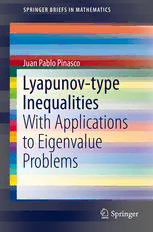Table Of ContentSPRINGER BRIEFS IN MATHEMATICS
Juan Pablo Pinasco
Lyapunov-type
Inequalities
With Applications
to Eigenvalue
Problems
123
SpringerBriefs in Mathematics
SeriesEditors
KrishnaswamiAlladi
NicolaBellomo
MicheleBenzi
TatsienLi
MatthiasNeufang
OtmarScherzer
DierkSchleicher
VladasSidoravicius
BenjaminSteinberg
YuriTschinkel
LoringW.Tu
G.GeorgeYin
PingZhang
SpringerBriefs in Mathematics showcases expositions in all areas of
mathematics and applied mathematics. Manuscripts presenting new results
or a single new result in a classical field, new field, or an emerging topic,
applications, or bridges between new results and already published works,
are encouraged. The series is intended for mathematicians and applied
mathematicians.
Forfurthervolumes:
http://www.springer.com/series/10030
Juan Pablo Pinasco
Lyapunov-type Inequalities
With Applications to Eigenvalue Problems
123
JuanPabloPinasco
DepartamentodeMatematica
UniversidaddeBuenosAires
BuenosAires,Argentina
ISSN2191-8198 ISSN2191-8201(electronic)
ISBN978-1-4614-8522-3 ISBN978-1-4614-8523-0(eBook)
DOI10.1007/978-1-4614-8523-0
SpringerNewYorkHeidelbergDordrechtLondon
LibraryofCongressControlNumber:2013947680
MathematicsSubjectClassification(2010):34L15,34B05,34B15,34C10,35P30
©JuanPabloPinasco2013
Thisworkissubjecttocopyright.AllrightsarereservedbythePublisher,whetherthewholeorpartof
thematerialisconcerned,specificallytherightsoftranslation,reprinting,reuseofillustrations,recitation,
broadcasting,reproductiononmicrofilmsorinanyotherphysicalway,andtransmissionorinformation
storageandretrieval,electronicadaptation,computersoftware,orbysimilarordissimilarmethodology
nowknownorhereafterdeveloped.Exemptedfromthislegalreservationarebriefexcerptsinconnection
with reviews or scholarly analysis or material supplied specifically for the purpose of being entered
and executed on a computer system, for exclusive use by the purchaser of the work. Duplication of
this publication or parts thereof is permitted only under the provisions of the Copyright Law of the
Publisher’slocation,initscurrentversion,andpermissionforusemustalwaysbeobtainedfromSpringer.
PermissionsforusemaybeobtainedthroughRightsLinkattheCopyrightClearanceCenter.Violations
areliabletoprosecutionundertherespectiveCopyrightLaw.
Theuseofgeneraldescriptivenames,registerednames,trademarks,servicemarks,etc.inthispublication
doesnotimply,evenintheabsenceofaspecificstatement,thatsuchnamesareexemptfromtherelevant
protectivelawsandregulationsandthereforefreeforgeneraluse.
Whiletheadviceandinformationinthisbookarebelievedtobetrueandaccurateatthedateofpub-
lication,neithertheauthorsnortheeditorsnorthepublishercanacceptanylegalresponsibilityforany
errorsoromissionsthatmaybemade.Thepublishermakesnowarranty,expressorimplied,withrespect
tothematerialcontainedherein.
Printedonacid-freepaper
SpringerispartofSpringerScience+BusinessMedia(www.springer.com)
To Ceci, Fede, andSelva
Preface
I used to think that the Sturm–Liouvilletheory of second-orderordinarydifferen-
tial equations was one of the most beautiful areas of mathematics. Its simplicity,
togetherwiththepowerofthecomparisonandoscillationtheorems,shedadiffer-
entlightonsecond-orderordinarydifferentialequations.However,whilereadinga
transcriptionofatalkofG.C.Rota,Irealizedsomething:therearemanyinteresting
problems,both of theoreticaland applied origin,that cannotbe analyzedwith the
Sturmiantools.
TaketheunitballinRN:justthesimplereductiontopolarcoordinatesintroduces
the coefficient rN−1, which vanishes at the origin and is bounded above by 1, for
allN. Moreover,Bessel, Hermite,Legendre,..., almostallthe specialfamiliesof
functionsthatappearaseigenfunctionsofsecond-orderordinarydifferentialopera-
tors,areindeedeigenfunctionsofsingularordegenerateoperators,andtheSturmian
argumentsfail.Whatcanwedonow?
∞
IfwewritetheSturmianboundsinmodernnotation,weareusingtheL norm
ofthe weight,andwhathappensif we changeitto anothernorm,say L1? Indeed,
the answer is known,and it is related to the stability of solutionsof second-order
differential equations, a problem studied by Lyapunov almost 150 years ago. He
introducedan integralconditionthatthe weightmustsatisfy in orderto guarantee
stability. However, he never proved Lyapunov’sinequality. Later, Borg, Hartman,
Krein,andothermathematiciansworkingonstabilitygavehisnametothiskindof
SturmianboundwithanL1 norm.
However,unboundeddomainsstillpresentadifficulty,sinceLyapunov’sinequal-
ityincludesthelengthoftheintervalonwhichtheproblemwasstudied.Wemight
decidetoignorethisproblem,dismissingitasahifalutintheoreticalquestion.But
not so fast! It was, in fact, a legitimate question, inspired by quantum mechanics
and related to the number of bound states of the Schro¨dinger equation. Ordinary
differentialequationsonunboundedintervalswerestudiedinthe1950sand1960s
by Jost, Pais, Bargmann, Calogero, Cohn, and Nehari (the only one who was not
thinking of quantum-mechanicalproblems), among several others. They obtained
beautifulinequalities,involvingdifferentnormsofthecoefficients.
vii
viii Preface
Andinthelasttwentyyears,manymathematicianshaveextendedthoseresultsto
avarietyofsettings,includingp-Laplacianoperators,ordinarydifferentialequations
inOrliczspaces,N-dimensionalproblems,andsystems.
I designed this book as a guided tour throughthose results, together with their
applicationstoeigenvalueproblems,presentingfullproofsandextensionsofthose
inequalities, and showing the less-traveled paths, suggesting directions for future
work.Itriedtoincludeinthereferencesalltherelevantpapersonthissubject,and
Iapologizeherefortheinevitableomissions.
Iwishtothankseveralpeoplewhocontributeddirectlyorindirectlytothisbook:
P. Amster, J.M. Castro, P. De Na´poli, J. Ferna´ndezBonder,and A. Salort. Also, I
wish to thank the people at UCo-CEMIC, Buenos Aires, for their hospitality, and
thefinancialsupportfromUniversidaddeBuenosAiresandCONICET.
BuenosAires,Argentina JuanPabloPinasco
Contents
1 Introduction................................................... 1
1.1 AFewWordsAboutFourTheorems........................... 1
1.2 OrganizationoftheBook .................................... 7
2 Lyapunov’sInequality .......................................... 11
2.1 TheClassicalInequality..................................... 11
2.1.1 TheLinearCase ..................................... 11
2.1.2 AnInterestingExtension.............................. 16
2.2 QuasilinearProblems ....................................... 18
2.2.1 ASimpleProof...................................... 19
2.2.2 RelationshipwithIntegralComparisonTheorems ......... 20
2.3 SomeIncompleteGeneralizations............................. 23
2.3.1 Higher-OrderQuasilinearProblems..................... 23
2.3.2 NonconstantCoefficients.............................. 26
2.3.3 SingularCoefficients ................................. 27
2.3.4 OptimalityoftheConstants............................ 28
2.4 EigenvalueProblems:LowerBoundsofEigenvalues ............ 33
2.4.1 OptimalityoftheBound .............................. 34
2.4.2 ADifferentBound ................................... 36
3 Nehari–Calogero–CohnInequality ............................... 39
3.1 TheWorkofCalogeroandCohn.............................. 39
3.1.1 Cohn’sProof........................................ 40
3.1.2 Calogero’sProof..................................... 42
3.1.3 APartialConverse ................................... 43
3.2 Nehari’sProofandGeneralizations............................ 43
3.2.1 Nehari’sProofforSecond-OrderProblems............... 44
3.2.2 Nehari’sProof for LinearHigher-OrderDifferential
Equations........................................... 50
3.3 TheInequalityfor p-LaplacianProblems....................... 54
3.3.1 AnExtensionforDifferentPowers...................... 58
ix

